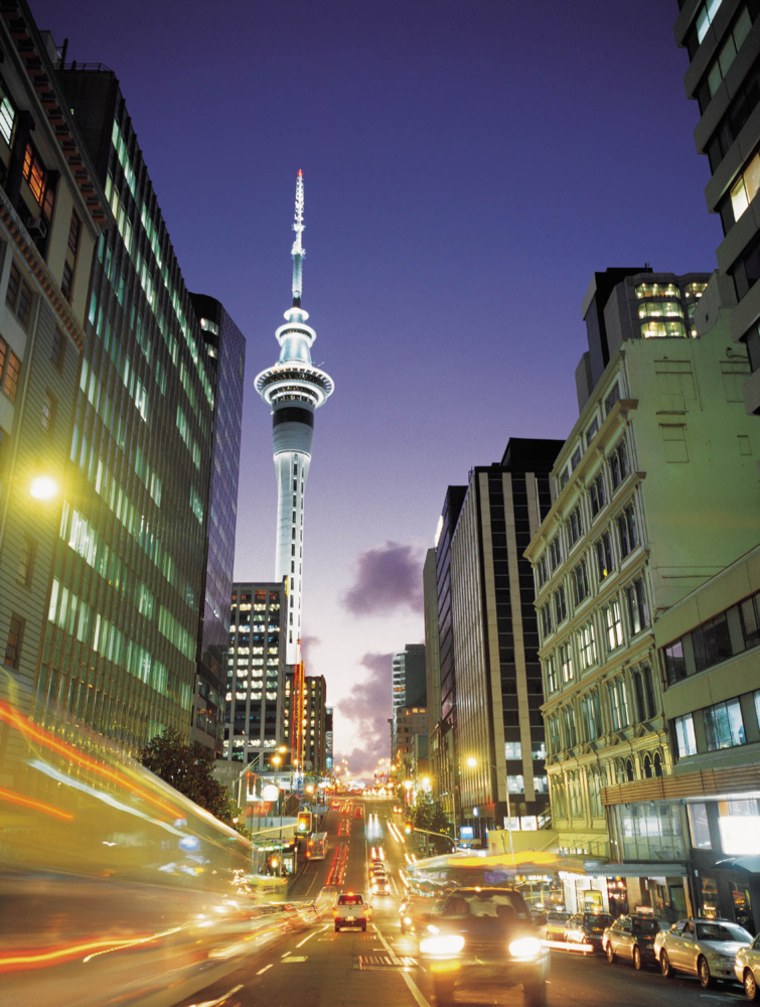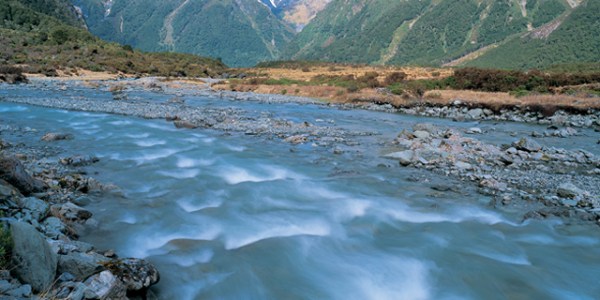The trail traverses one of the most dense and lush rain forests I've hiked through anywhere in the world. Only a trickle of sun manages to make its way through the thick tree canopy above, from which a virtual aviary of birds entertains with a symphony of song.
Towering, snow-capped mountains stretch to the horizon, overlooking valleys so packed with sheep they almost hide the carpet of grass on which they graze.
I dig my toes into the soft, white sand of a beach that stretches in both directions as far as the eye can see. Seals clamber over an outcrop of gray rocks at the edge of the water, occasionally plunging into the frothy sea below for a refreshing dip.
Any of these experiences could be among highlights of a memorable vacation trip. What makes them so enticing in New Zealand is that such variety is crammed into so compact a space.
For its size, about the same as Colorado, New Zealand offers more to-see's and to-do's than many much larger countries. That diversity is among reasons why so many travelers place it high on their list of favorites.
Still not convinced? Keep in mind that because New Zealand is below the equator, its seasons are opposite those in the United States. Right now, rather than shivering in the cold, you could be basking in summer breezes, bathing off talcum-soft beaches, and taking in some of the most spectacular scenery in the world.
Slideshow 9 photos
Explore New Zealand
The ease of travel is another appeal. The people speak English, and are extremely friendly and eager to help visitors. The compressed size makes getting around quick and easy. And inviting alternatives await those who, like me, are not seeking the ultimate adventure.
For example, those who prefer not to drive on the left side of the road may prefer the efficient, value-priced intercity bus system. And while the country is laced with challenging hiking trails, there's also a wide choice of inviting gentle, well-groomed paths.
Mention New Zealand and many people correctly conjure up images of some of the most magnificent natural features in the world. Landscapes range from sandy beaches to rugged coastlines, flat plains to soaring mountains, sprawling meadows to steaming thermal pools.
Much of this beauty reminds travelers of scenery they have seen elsewhere. The rolling pastureland, offset by bright yellow touches of gorse and broom bushes, resembles many an English landscape. Crystal clear, mountain-encircled bodies of water in Fiorland National Park serve as reminders of Norway. And anyone who has gazed in awe at the spine of jagged peaks that runs down South Island knows why they're called the Southern Alps.
Auckland, with its international airport, is a good place from which to begin a tour of North Island on its golden beaches. Ninety Mile Beach at the northernmost tip, closest to the warming equator, is the best-known stretch of sand. But in a region referred to as "Land of 1,000 beaches," the biggest challenge is deciding where to spread your blanket.
More visitors are drawn to South Island, with contrasting landscapes and views that greet the eye around almost every turn of the road. The mountain scenery reaches its pinnacle at the summit of Mt. Cook, which towers over 13,000 feet above the landscape. Glaciers inch their way down mountainsides, in places almost to the sea. The waters of deep fiords and lakes, the result of 500 million years of sculpting by the elements, double the beauty by reflecting their surroundings.
Alternatives for enjoying this dramatic display are as varied as the terrain itself. Rugged outdoor types may opt for activities like mountain climbing, long-distance trekking and whitewater raft trips down rushing rivers. Those who prefer more sedate encounters with nature may hike on gentle trails through terrain ranging from lush rain forests to growths of towering centuries-old trees, or climb into land and water vehicles to take in the sights as someone else drives.
Hiking is a way of life for many New Zealanders, and the selection of trails and environments seems endless. My experiences ranged from strolls of less than an hour to almost day-long explorations.
The Truman Walk, on the northwest coast of South Island, is a short trail that leads through a rainforest to cliffs overlooking the crashing Tasman Sea below.
Typical of the variety is the choice of close-by excursions available to guests of Grasmere Lodge where I spent several nights, nestled below the towering Southern Alps. They include strolls through valleys and rolling tundra, trails in subalpine forest terrain, jaunts to elevated snow fields and technical mountain climbing.
There also a wide selection of water experiences, ranging from sedate guided boat tours to gentle lake kayaking to rough-and-tumble whitewater rafting. I opted for a memorable sea kayak paddle through Milford Sound. That dramatic, 13-mile-long fiord is the best known body of water in Fiordland National Park in the southwest corner of South Island.
Our four-hour paddle covered about half that distance, with numerous stops along the way to gaze in awe at the scenery and listen to our guide describe the area's history and geology.
Sheer mountains hide their peaks in the clouds, then plunge almost vertically into the crystal-clear water. Narrow rivulets formed by melting snow high above tumble down over rocky cliff faces. A fur seal resting on a rock, disturbed by our arrival, cast what appeared to be an annoyed glance in our direction. A crested penguin, enjoying its bath in the icy water, simply ignored us.
Even before this once-in-a-lifetime scene had a chance to be permanently etched in my mind's eye, I found myself immersed in another that rivaled it in breathtaking beauty. The Southern Scenic Route, which winds along the lower end of South Island, took a place high on my "most scenic drives" list within the first few miles. Its myriad views – rolling green fields being mowed by grazing sheep, towering peaks sporting a jaunty snow cap, tiny villages, waves crashing on graggy shoreline -- prompt frequent stops to take yet another photograph.
It is this never-ending display of the best that the outdoors has to offer which attracts most visitors to New Zealand. The show also extends to the world of wildlife. Forests are alive with animals and birds, including rare species that have disappeared elsewhere but flourish on this isolated island terrain.
The world's smallest marine dolphin and rarest sea lion are found only in New Zealand waters. The tuatara, the oldest living reptile, has a life expectancy of 300 years and traces its lineage back 190 million years.
But it is the bird life that most fascinated, entertained and amused me.
Nowhere else may you encounter the kea, the only alpine parrot, or hope to see the endangered takahe, a large flightless bird.
Walking through the woods, you're often treated to an overhead concert that ranges from chirps and peeps to other less familiar sounds. I was able to identify clicks, creaks whistles, laughs and, emanating from one treetop triller, what I can only describe as similar to the ring of a cell phone.
Best known is the kiwi, a whimsical creature indeed, with its pear-shaped body, sturdy legs, plump backside and long beak. While kiwis are observed during chance encounters, the best opportunity for seeing them is during an organized nighttime spotting excursion, an exercise as unusual as the bird itself.
Lending an overlay of colorful history to New Zealand as a showplace of nature is the enticing story of the Maori. When the first European settlers landed in the early 19th century, they found the plains and forests inhabited by a Polynesian people who had arrived there about 800 years earlier after crossing the sea from other islands in double-hulled sea-going canoes. Today, about 15% of New Zealand's population of four million is of Mairo (pronounced MAH-ree) descent.
The Maori have maintained a rich culture that embodies their interaction with both the natural and spiritual worlds. Central to their beliefs is a close connection with the environment that combines respect and efforts to protect it. The Maori world-view links everything and every one in an extended family.
Introductions to the Maori people and lifestyle are constant -- in tongue-twisting place names for lakes, mountains and other natural attractions, and colorful legends that seem to explain virtually every aspect of life. Visitors may observe and experience Maori customs and lifestyle during presentations at marae (meeting places) and other venues.
The spiritual richness of the Maori culture is augmented by the warm friendliness of the kiwis, as New Zealanders refer to themselves. The beauty of the countryside is as varied as opportunities for exploring and enjoying it. For more information about this magnificence in miniature, log onto newzealand.com.
Travelworld International Magazine is one of the Web's best and most visited online travel magazines, with over 75,000 visitors a month. Travelworld Magazine features articles, columns, and photos from members of the North American Travel Journalists Association. For more information on Travelworld Magazine, please contact the NATJA by phone (310) 836-8712 or email at .

